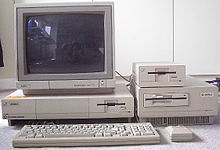A1060 sidecar
The A1060 sidecar (of English. "Sidecar" = sidecar or trailer), or the XT Bridge Board was a stand-alone PC (based on the Intel 8088 ) mounted on the right side of the Amiga 1000 is connected. The IO area of the 8088 was displayed in the address space of the Amiga host system using shared memory . Data exchange was possible between Amiga and Sidecar.
The sidecar made it possible to work on just one monitor , keyboard , mouse and printer on two different computers at the same time. So MS-DOS applications were executed in a window of the Amiga operating system and could also use the peripherals of the Amiga. With the sidecar it was also possible for the first time to equip the Amiga 1000 with a hard disk by installing a file card , which could be used by both parts of the team.
The sidecar was created in the Braunschweig development department of Commodore because they had experience with the PC architecture thanks to the Commodore PC series .
Due to the high system costs of both the Amiga 1000, which was quickly replaced by cheaper ( Amiga 500 ) and more easily expandable ( A2000 ) variants, and the sidecar itself, which was actually a Commodore PC 10 without graphics card and keyboard ( it even had its own power supply unit), the sidecar had a relatively short life.
The successors of the Sidecar were the various bridgeboards , which also represented a complete PC, but this on a plug-in card in a Zorro slot of an A2000, A3000 or A4000. They were available from Commodore with 8088 (A2088), 80286 (A2286) and 80386SX (A2386SX) processors. The XT bridgeboard is referred to in the (German) manual and on the board itself as a "PC emulator", and the specialist literature also referred to the MS-DOS emulator.
Later there were also PC emulator cards (e.g. the KCS Power PC Board ) from other suppliers for other Amiga models, such as the Amiga 500 or Amiga 500 plus . In the following years software emulators became more popular, such as B. PCTask or PCx , because the increased performance of the 68060 - or powerUP -based Amigas was sufficient for this.
Technical specifications
Sidecar
- Year of publication: 1986
- RAM: 256 KByte, later 512 KByte
- CPU: Intel 8088, 4.77 MHz
- New price: approx. 1500 DM
- Special features: battery-backed real-time clock, complete IBM XT , runs parallel to the Amiga
- PC outputs run on the Amiga screen and printer connected to the Amiga.
- PC input is via the Amiga keyboard and mouse.
A2088 (XT) bridgeboard
- RAM: 512 KByte, could be expanded to 640 KB with expansion cards
- Base for mathem. Coprocessor 8087
- the 8088 can be exchanged for an NEC V20
- Special features: runs parallel to the Amiga, but has to be started with the binddrivers command , use of MFM and RLL hard disks with the appropriate controller is possible, an Amiga partition (jh0 :) can be set up on these hard disks, but the Amiga cannot boot from this .
- Text and graphics output as a task via the Amiga screen or via a PC graphics card ISA to an external monitor
- Input via Amiga keyboard and mouse
- ISA slots on the main board of the Amiga 2000 : 2 available 8-bit ISA slots (can be converted into these by soldering in 16-bit slots), 1 available 16-bit ISA slot, the 2nd 16- The bridge board itself occupies the bit slot
- Connection for an external Amiga floppy drive on the back, this 880 KB Amiga drive is then used as a 720 KB PC drive
- Internal connection for 360 KB floppy disk drive
- Connection for loudspeaker (jumper J2, internal)
- The parallel interface of an Amiga can be used as LPT1.
The following disks were included in the scope of delivery:
Software for the Amiga
- special workbench disk for version 1.2
- PC Install for Workbench 1.3
- AmigaJanus for Workbench 2.1
Software for the PC
- MS-DOS 3.2 (two 5-1 / 4 "floppy disks) for XT bridgeboard
- MS-DOS 3.3 (three 5-1 / 4 "floppy disks) for all bridgeboard versions
In contrast to other MS-DOS versions, these floppy disks contain special software that enables data exchange, the use of the Amiga mouse and the query of the Amiga system time.
A2286 (AT) bridgeboard
- Bridgeboard with CPU Intel 80286
A2386X (AT) bridgeboard
- Bridgeboard with CPU Intel 80386 SX
Supported Operating Systems
In addition to MS-DOS, it was possible to run Windows 3.11 with the A2386SX . For this, the bridgeboard had to contain a sufficient amount of RAM and its own ISA graphics card had to be used, which could handle the VGA display that an Amiga 2000 could not display.
